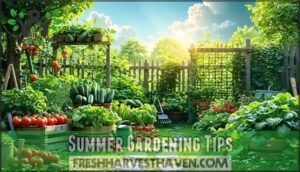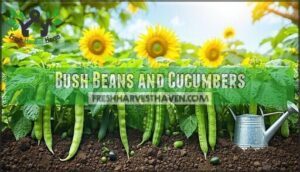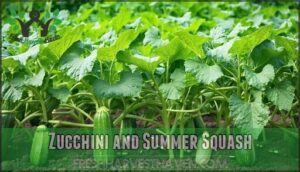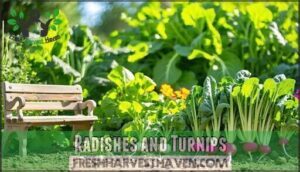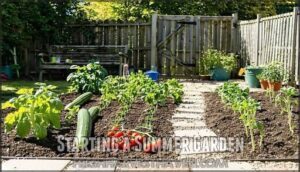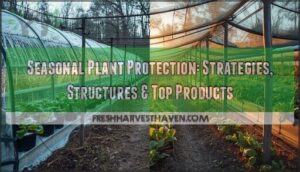This site is supported by our readers. We may earn a commission, at no cost to you, if you purchase through links.
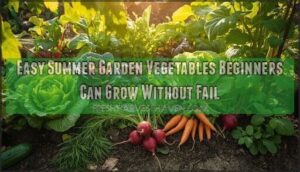
Start with lettuce varieties that thrive in loose soil with minimal fuss—just harvest outer leaves while the center keeps growing.
Radishes deliver results in just 20-30 days, perfect for instant gratification.
Bush beans and cucumbers make excellent companions since beans naturally fix nitrogen in the soil.
Spinach and kale pack serious nutrition while tolerating heat better than you’d expect.
Root vegetables like carrots and beets need stone-free, loose soil but rarely face pest problems.
These reliable choices build your confidence while your green thumb develops naturally, and they are great for beginners who want to see quick results with minimal fuss.
Table Of Contents
- Key Takeaways
- Easy Summer Vegetables
- Beginner Garden Essentials
- Summer Gardening Tips
- Fast Growing Summer Vegetables
- Starting a Summer Garden
- Frequently Asked Questions (FAQs)
- What are the easiest vegetables to grow in summer?
- What is the easiest vegetable garden for beginners?
- What is the most common mistake of first time gardeners?
- How do you start a summer vegetable garden?
- When should I start harvesting my vegetables?
- How do I prevent pests from damaging crops?
- What tools do beginner gardeners actually need?
- Can I grow vegetables in containers successfully?
- How often should I fertilize summer vegetables?
- When should I start seeds indoors?
- Conclusion
Key Takeaways
- Start with fast-growing varieties like radishes (20-30 days) and lettuce that provide quick wins and instant gratification while you’re learning basic gardening skills.
- Choose foolproof options like bush beans, cucumbers, and leafy greens that forgive beginner mistakes and thrive with minimal care in well-draining soil.
- Focus on essential tools (hand trowel, watering can, gloves) and basic soil preparation rather than expensive equipment—you don’t need fancy gear to succeed.
- Pick companion plants like bush beans and cucumbers that naturally support each other, with beans fixing nitrogen in the soil for better overall garden health.
Easy Summer Vegetables
You can easily grow nutritious vegetables in your summer garden even if you’re completely new to gardening.
Start with fast-growing options like lettuce, radishes, and bush beans that forgive beginner mistakes and produce food quickly, allowing for a nutritious harvest.
Leafy Greens Like Lettuce
Lettuce varieties offer the perfect gateway into Green Gardening for beginners seeking easy gardening tips.
These leafy greens thrive in loose soil with minimal fuss, making Lettuce Care surprisingly straightforward.
You’ll harvest outer leaves first while centers continue growing, giving you continuous summer garden vegetables.
Plant early spring varieties or choose heat-tolerant types for your beginner garden ideas success.
Spinach and Kale Varieties
Powerhouse leafy greens like spinach and kale thrive in your summer garden vegetables setup with surprising heat tolerance.
These cool weather champions deliver exceptional spinach nutrition and diverse kale types for your beginner garden ideas.
Malabar spinach climbs vertically while curly varieties resist wind damage. Both offer easy gardening tips with minimal pest control.
Harvest tips include picking outer leaves first, allowing continuous growth throughout the season for maximum yields. Understanding easy to grow vegetables is key to a successful summer garden with maximum yields and easy gardening.
Root Vegetables for Beginners
Root vegetables offer beginner-friendly success stories in your summer garden vegetables journey.
These cool-weather crops tolerate basic soil prep and deliver impressive harvests with minimal fuss.
- Radishes sprint to maturity in 20-30 days, making radish care perfect for instant gratification
- Carrots need loose, stone-free soil but reward you with minimal pest issues
- Beets provide double rewards—sweet roots plus nutritious greens for beet harvest flexibility
Beginner Garden Essentials
You don’t need fancy equipment to start vegetable gardening 101. A hand trowel, garden rake, and watering can handle most tasks. Quality gloves protect your hands while you’re getting down and dirty.
Garden planning begins with mapping your space. Sketch sunny and shady areas, then match easy to grow vegetables to their preferred conditions. Test your soil’s pH using an inexpensive kit—most summer garden vegetables prefer slightly acidic to neutral soil.
Here’s your beginner garden essentials checklist:
| Tool Category | Must-Have Items |
|---|---|
| Hand Tools | Trowel, pruning shears |
| Site Prep | Rake, soil pH kit |
| Planting | Seed trays, small pots |
| Maintenance | Watering can, gloves |
Using the right garden hand protection is essential for beginner gardeners. Soil preparation sets you up for success. Avoid beginner mistakes by testing before planting—your vegetables will thank you later.
Summer Gardening Tips
Growing summer vegetables successfully requires attention to three key factors that make or break your harvest.
You’ll need to match your plant choices with proper sunlight exposure, soil conditions, and structural support to guarantee your garden thrives through the hot months, which includes considering complete concepts.
Full Sun Requirements
Your summer garden vegetables need six to eight sunlight hours daily for peak performance. Full sun plants like tomatoes and peppers struggle without adequate direct sun exposure.
Warm weather crops require consistent light – anything less than six hours cuts yields dramatically. Map your garden’s sun patterns throughout the day.
Soil temperature rises faster in sunny spots, benefiting heat-loving varieties. Position easy to grow vegetables where they’ll receive uninterrupted morning-to-afternoon light for maximum harvest success.
Understanding sunlight requirements is essential for ideal plant growth and development.
Soil and Watering Needs
Soil quality makes or breaks your summer vegetable garden. Start with well-drained soil that won’t leave roots sitting in puddles—nobody likes soggy feet!
Mix in compost to boost nutrients and improve texture. Most easy to grow vegetables thrive in soil with pH between 6.0-7.0.
Water requirements are simple: deliver one inch weekly through deep, consistent sessions rather than daily sprinkles.
Drainage systems like raised beds prevent waterlogging, while organic fertilizer types feed plants steadily. Monitor moisture with your finger—if it’s dry two inches down, it’s time to water.
Support for Climbing Plants
Since climbing vegetables like cucumbers and pole beans can increase yields by 30%, proper support systems are essential for summer gardening success.
Trellis systems and plant stakes prevent overcrowding while maximizing your container gardening space. Understanding the role of a bamboo trellis can help gardeners choose the best support for their plants.
Here are three effective support options:
- Bamboo teepees – Perfect for lightweight climbers and container gardening
- Wire fencing panels – Ideal for heavy fruiting plants requiring sturdy lattice frames
- Garden arbors with string – Budget-friendly trellising for peas and beans
Fast Growing Summer Vegetables
When you want quick results from your summer garden, these fast-growing vegetables deliver impressive harvests in just weeks.
You’ll be amazed how quickly radishes pop up in 20-30 days, while bush beans and zucchini provide continuous harvests all season long.
Bush Beans and Cucumbers
Two powerhouse easy-to-grow vegetables make your summer vegetable garden incredibly productive.
Bush beans and cucumbers thrive as companion plants, creating perfect garden spacing while beans naturally enrich soil through nitrogen fixation.
Both require similar soil preparation – warm, well-draining conditions above 65°F.
Choose reliable bean varieties like Provider or Cherokee Trail alongside cucumber care favorites like Straight Eight.
Harvest timing matters: pick beans every 2-3 days when pods snap, cucumbers daily at 6-8 inches.
This beginner gardening duo delivers continuous harvests throughout summer with minimal fuss.
For maximum growth, understanding bush bean planting techniques is essential to maximize yields and create a productive garden.
Zucchini and Summer Squash
Zucchini and summer squash will transform your beginner gardeners’ plot into a powerhouse of production. These easy-to-grow vegetables thrive in your summer vegetable garden with minimal fuss.
Your zucchini care routine starts with proper spacing—give each plant 3-4 feet since they’ll spread like nature intended. For vertical gardening enthusiasts, some squash varieties climb trellises beautifully.
Here’s your success formula:
- Plant spacing – Allow 3-4 feet between plants for ideal air circulation
- Harvest timing – Pick zucchini when 6-8 inches long for peak tenderness
- Garden pests monitoring – Watch for squash bugs hiding under leaves
- Watering technique – Water at soil level to prevent powdery mildew
These summer squash varieties mature in just 40-60 days, rewarding you with abundant harvests throughout the season. To maximize yields, understanding best summer vegetables is vital for a thriving garden.
Radishes and Turnips
While zucchini rewards you with abundance, root vegetables deliver speed that’ll make your head spin.
Radishes race from seed to harvest in just 20-30 days, while turnips follow close behind at 40-60 days. These easytogrow vegetables are perfect for your summer vegetable garden when you want quick wins.
Your radish care routine couldn’t be simpler – scatter seeds in loose soil and water regularly. Turnip recipes await when you harvest these versatile roots that taste amazing both raw and cooked.
Here’s your root harvest game plan:
| Feature | Radishes | Turnips |
|---|---|---|
| Days to Harvest | 20-30 days | 40-60 days |
| Best Varieties | Cherry Belle, French Breakfast | Purple Top, Hakurei |
| Growing Tips | Pull when 1-inch wide | Harvest young for sweetness |
| Companion Plants | Lettuce, carrots | Beets, onions |
| Storage Method | Refrigerate 2-3 weeks | Cool, dry place |
Focus your garden planning on soil preparation – both thrive in loose, well-draining dirt. This beginner gardening guide guarantees success with minimal fuss.
Starting a Summer Garden
You’ll be amazed at how quickly you can transform any sunny spot into a productive vegetable garden with the right planning and preparation.
Success starts with selecting the perfect location, preparing your soil properly, and following simple planting guidelines that set your summer crops up for healthy growth.
Choosing The Right Location
Where should you place your summer garden for maximum success? Sun exposure drives your decision since most vegetables need six to eight hours of direct sunlight daily.
Garden location affects everything from growth rates to harvest quality.
Consider these key factors for ideal terrain assessment:
- Sunlight duration – Choose southern or western exposures for best light
- Soil quality – Test drainage by digging holes after rain
- Climate zones – Avoid frost pockets and windy areas
- Garden layout – Plan 18-24 inches between rows for airflow
Well-drained soil prevents root rot while accessible paths encourage consistent care.
Preparing The Soil and Seeds
After you’ve selected your spot, soil preparation becomes your garden’s foundation for success. Start by testing your soil’s pH—most vegetables thrive between 6.0 and 7.0, and adjusting it now prevents 35% slower growth rates later.
Mix 2-4 inches of compost into your existing soil to boost organic matter by 10-40%, creating that well-drained soil vegetables crave. For seed starting, you’ll want soil temperatures hitting at least 60°F before planting.
Pre-soaking seeds for 24 hours increases germination success by 21% for beans and peas. Choose certified disease-free seeds to cut crop failure risk by 30-50%.
Here’s what proper soil preparation gives you:
- Rich, dark earth that smells like a forest floor after rain
- Seedlings that pop up enthusiastically instead of struggling through hard clay
- Roots that spread freely instead of hitting brick-wall barriers
- Plants that practically grow themselves with minimal fuss
Understanding soil test results is vital for creating a balanced ecosystem. Remember: healthy soil creates happy plants that’ll reward your efforts all season long.
Planting and Maintenance Tips
Through thoughtful soil preparation and consistent watering schedules, you’ll set your summer garden up for success.
Plant seeds at twice their width depth, water gently but regularly, and apply balanced fertilizer every few weeks.
Pull weeds before they compete for nutrients, and practice simple pest management by hand-picking aphids and caterpillars early.
Effective summer garden planting techniques also involve maintaining ideal soil conditions to support healthy plant growth.
Frequently Asked Questions (FAQs)
What are the easiest vegetables to grow in summer?
You’ll have great success with zucchini, green beans, and cucumbers.
They’re heat-loving champions that practically grow themselves.
Plant after your last frost, give them sunshine and water, and you’ll be harvesting in just 50-60 days.
What is the easiest vegetable garden for beginners?
Don’t think you need years of experience—you’ll succeed with beginner-friendly crops! Start with radishes, lettuce, and green beans. They’re forgiving, mature quickly, and require minimal care.
What is the most common mistake of first time gardeners?
You’ll often crowd your plants, forgetting they need space to breathe and grow.
Roots tangle, leaves compete for sunlight, and everything struggles.
Give each seedling room to stretch—your garden’s health depends on that simple act, which is crucial for them to grow.
How do you start a summer vegetable garden?
Start after your last frost date by choosing a sunny spot with well-draining soil. Plant heat-loving crops like tomatoes, cucumbers, zucchini, and peppers from transplants for faster results.
When should I start harvesting my vegetables?
Perfect timing releases flavor’s peak potential.
Harvest leafy greens like lettuce continuously by picking outer leaves.
Radishes emerge in just 20-30 days, while carrots need 60-75 days.
Pick zucchini at 6-8 inches for best taste and texture.
How do I prevent pests from damaging crops?
Use row covers during vulnerable seedling stages, rotate crops annually, encourage beneficial insects with diverse plantings, and apply organic sprays like neem oil when necessary for targeted pest control.
What tools do beginner gardeners actually need?
You’ll need a hand trowel, watering can, garden hose, pruning shears, gloves, and measuring tape. These six tools handle planting, watering, harvesting, and maintenance for most beginner crops.
Can I grow vegetables in containers successfully?
Tomato plants thriving in five-gallon buckets prove container gardening works brilliantly.
You’ll successfully grow lettuce, radishes, herbs, and peppers in pots with proper drainage, quality soil, and consistent watering.
Start small!
How often should I fertilize summer vegetables?
Feed your summer vegetables every 2-3 weeks with balanced fertilizer.
Heavy producers like tomatoes, peppers, and zucchini need more frequent feeding than leafy greens.
Stop fertilizing 4-6 weeks before first expected frost.
When should I start seeds indoors?
Starting seeds indoors isn’t rocket science—it’s your gateway to gardening freedom.
Begin tomatoes 6-8 weeks before your last frost date, peppers need 8-10 weeks, and cucumbers just 2-3 weeks for perfect timing.
Conclusion
Surprisingly, the hardest part about growing easy summer garden vegetables beginners love isn’t the actual gardening—it’s choosing which varieties to plant first.
You’ll discover that success comes naturally when you start with foolproof options like lettuce, radishes, and bush beans.
These reliable performers build confidence while teaching essential skills.
Remember, every expert gardener started exactly where you’re now, wondering if they’d actually harvest anything edible from their first plot, and with foolproof options, you can begin your journey.
- https://en.wikipedia.org/wiki/Phaseolus_vulgaris
- https://www.britannica.com/plant/zucchini
- https://planthardiness.ars.usda.gov/
- https://www.fs.usda.gov/wildflowers/pollinators/pollinator-of-the-month/hawk_moths.shtml
- https://extension.unh.edu/sites/default/files/migrated_unmanaged_files/Resource005477_Rep7652.pdf

